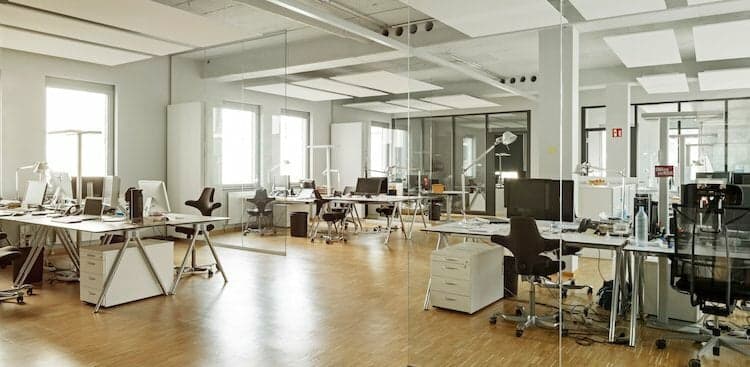Last year, my co-workers and I built our colleague a cubicle. She was on a month-long sabbatical, and, knowing she’d need all the help she could get to focus when she returned, we armed ourselves with cardboard boxes, a knife, a roll of tape, and a bottle of wine (obviously) and constructed one of our proudest editorial team accomplishments to date.
The running joke was that at a company with a hip and cool office plan (read: open office), the editorial team secretly longed for the good ol’ days of cubicles when you could close yourself off to noise, distractions, and nagging colleagues.
Knowing we weren’t the only team in the world wanting more personal space, I wondered: Why did so many organizations choose to go for the long tables, wall-less spaces, and exposed ceilings?
I did some digging.
Where Did Open Offices Come From?
You’re not going to believe this, but the open office pre-dates cubicles. They “were invented by architects and designers who were trying to make the world a better place—who thought that to break down the social walls that divide people, you had to break down the real walls, too,” says author George Musser of the Scientific American.
In 1939, Frank Lloyd Wright designed the Johnson Wax Headquarters, the main office for SC Johnson & Son. The office lacked any partition, but rather was divided up by thin white columns, filing cabinets, and oval desks.
I highly recommend watching this video if you want to learn more.
But what happened with Wright’s plan was that, like a lot of things, people took it to the extreme—companies started cramming employees into incredibly close quarters. And when we go to the extreme on one end, we usually end up doing it on the other end, which brings us to: the cubicle.
Tell Me More About Cubicles
“…[T]he cubicle was created as a way to save workers from the drudgery of open office plans. Workers by and large hated the open plan. It was noisy and distracting, and gave them no privacy. Most importantly, it made them feel like just another cog in the machine,” says Good & Co author Alec Recinos.
Sound familiar?
In 1960, Herman Miller launched the Herman Miller Research Corporation, which was created for the purpose of solving furniture issues. It was Miller who created the first office cubicle. With them, there was a sense of organization. There were even tax benefits to them.
This was great, until it wasn’t. Thanks in part to pop culture, the cubicle started getting a bad rap (think: Office Space), becoming synonymous with mass layoffs, mergers, and unstable work environments. Plus, with the privacy and quiet came the drawbacks—such as not seeing sunlight all day and being surrounded by a sea of grey-ness.
But, asks Recinos, “[i]f the cubicle was itself a solution to the open plan, why would designers and office managers once again return to open plan office designs?”
The answer: New tech companies wanted to “‘hack’ the status quo,” and believed open offices were the solution to issues of communication. This “caused what had previously been seen as the drawbacks of open plan office design—noise, distractions, and chaos—to be seen as positive qualities.” he adds.
How Do We Think About Designing Them Today?
“Breakout spaces are super important. And when I design offices that’s one of the first things people request,” says Tina Rich, a designer at Homepolish. “It’s just about having spaces to accompany different kinds of people or sizes of groups and also different activities. Maybe one area’s a lounge and it has a sofa in it, or the other one is more formal and it’s a conference room, or it’s a two-person phone booth. This helps allow you to have a bit of alone time if you need it.”
The way Rich approaches interior design isn’t just from an aesthetic angle but a practical one—not unlike Wright in the 1900s. Acoustics come into play, and Rich will consider where teams should be placed based on how often they’re talking on the phone or meeting. She’ll add finishes that absorb sound, such as rugs, drapes, or acoustical wall tiles. She’ll create a sense of “perceived privacy” with the use of desk partitions. She’ll factor in easy access to outlets.
When she’s collaborating with companies, she asks questions to get a sense of their workflow: “How many seats do you need? How many people are in each department and who needs to sit next to each other? Which teams are the loudest and which need more quiet? Where is the entry and where will people be congregating?”
The goal? Minimize the downsides.
Let’s Talk About the Downsides
I think the title of this 2018 Chicago Tribune article sums it up perfectly: “The Open Office Plan Is a Disaster.”
The author, Jeff Pochepan, cites one study that states that today, “54% of [high-performance employees] say their office environment is ‘too distracting.’”
Of course, there’s plenty of insight as to why. A BBC article mentions that many small distractions—uncontrollable factors such as phone calls, chatting co-workers, and the sounds of people walking around—tends to add up.
And, an absence of privacy does more than just kill productivity. A recent FastCo Design article discusses research that found that open offices lead to a “subtle kind of sexism,” where women are frequently judged by their male peers by appearances, both physical and emotional, on an everyday basis. This is obviously not good.
But It’s Not All Bad…
The beauty of open offices, Rich states, is that even in the most crowded places—New York, for example, where Rich is located—you can create a sense of loftiness. Suddenly, people feel a little more comfortable, a little less overwhelmed at work:
“And in an open office everyone is getting access to windows. In the last office I designed, one thing a client raved about was that they had tons of windows and tons of light.”
“We spend so much time in the office. It doesn’t have to be sterile and just functional,” she adds. Lounges, kitchens, couches, window nooks—these are all part of the open office plan that offer employees spaces where they can step away from their desks and take a breather.
And everyone’s on the same level. Rich notes that in many of the offices she’s designed, executives and CEOs don’t have their own offices: “They’re part of the team, they’re in there, sitting side by side with everyone.” And this creates that sense of teamwork—that no matter where you stand you’re chipping in.
This is what was originally intended when Wright designed the Johnson Wax Headquarters, right? A place where employees were thought of and treated like people, not cogs.
What doing all this research has taught me is that there will always be problems with the spaces we work in (or, sometimes we’ll blame the spaces for our bigger career issues). But we can also do our best to find practical solutions—such as the suggestions we rounded up here.
Or, you can always buy some cardboard boxes.

